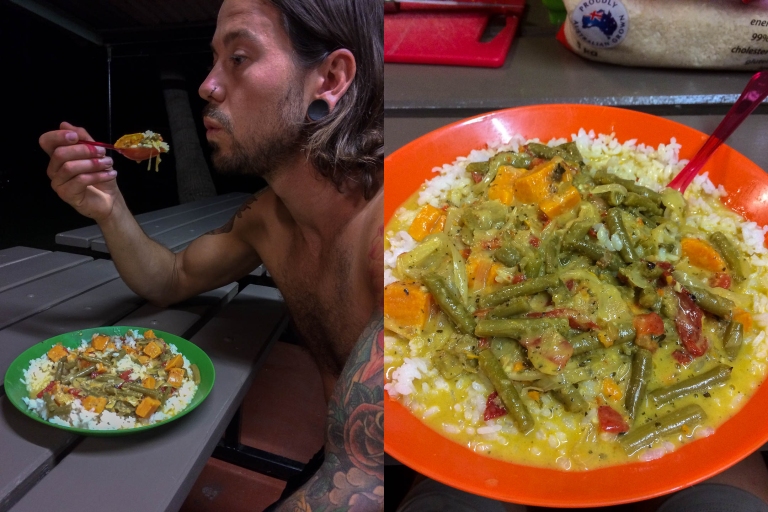I admit this isn’t the most exciting or adventurous topic to start a blog with – and for that, I do apologise.
However, wherever you are in the world, no matter your surroundings, the issues surrounding food – both buying, cooking and eating – will present themselves to you at one moment or another. It’s unavoidable.
Generally, our food conflicts were – and are – multi-faceted; price, health consciousness, the practicality of both storage and cooking, and quantity for consumption all can become problematic, particularly when you’re travelling.
When we were on the road in Australia, storage in our car was an issue we had to adapt to; a relatively limited space and lack of refrigeration meant we couldn’t bulk buy and could only plan ahead several days. Plus, come to our arrival in Darwin, our cool box had become a hot box so all fresh produce had to be avoided or incinerated.
Nearly every ingredient had to come from a tin or a bottle; neither a cost-effective way of eating nor the healthiest. However, tinned food does not require a great deal of preparation, so meals were relatively easy and consumed minimal fuel.
You can be surprisingly creative; spaghetti bolognese works relatively well with tinned corned beef (beef stock cubes are essential), while you can cover most veggies in coconut milk and pre-mixed spices and call it a Thai curry.

Of course, we were relieved when our six-month work placement came with a cabin, fully equipped with an oven, microwave, fridge and freezer – an absolute luxury over the hot summer. (We also managed to acquire an outdoor BBQ).
The added benefit of staying in one place is scoping out the local supermarket(s) for their marked-down prices. I don’t think we ever bought full-priced meat items and usually bought discounted fruit and veg. Weekday evenings were the best time to sneak a bargain. We never quite resorted to bin-diving but were informed which were best in the area by fellow travellers.
Despite better facilities, some on-road habits never quite left us, for instance, buying UHT milk rather than fresh, adding Sriracha Hot Sauce to everything, and knowing a tin of tomatoes can become any meal with the right seasoning.
The price of food is, of course, always relative to the price of everything else.
At home in the UK, while we were budgeting for travel, we became increasingly aware that the cost of food was becoming more expensive. The solution was simple yet sometimes laborious; week-ahead meal plans (only buy what you need), slow-cooker days (one dish, several meals), bulk-buying (better value for money), own-brands, and splitting the shopping list across multiple supermarkets to get the best price.
In Australia, we adapted our plan as best as possible around road-life. We bulk-bought everyday essentials, such as our olive oil (a 2Ltr can last a year), spices (from Kakulas Bros in Perth), rice (a 5Kg bag can last several months) and onions (from Spudshed); we avoided small, rural supermarkets where the price fluctuation could be double that of anywhere else, and tried to keep to a regular set of dishes throughout the week. Still, we averaged around $15/day for food purchases.
There were days when our lunch was nothing more than a peanut butter sandwich, or our dinner was instant mash and baked beans. But generally we tried to keep our diet varied, nutritious and affordable – a sentiment that wasn’t shared by all backpackers!
One of the first European travellers we met, while staying near Margaret River, lived exclusively on pasta with pesto and cheese. Every day (or so he told us). The same traveller also was the first to recommend Tasmania to us, to that we are very grateful.

The cost of food shopping in New Zealand has, so far, been eye-watering. Fresh produce prices undulate “with the markets,” according to supermarket staff so it’s quite normal, for example, a capsicum pepper to go from $0.99 to over $3 (each) within the space of a week. Meat is generally expensive, but more surprisingly, so is the dairy – despite, like the UK, dairy is a primary industry.
I have no doubt that the country’s low relative population, location, seasonality and its ability to grow its own (vs import) have their effect on food prices here, though I’m not an expert in economics to specify. What I have observed, however, is that the usual “tricks” for buying inexpensively do not readily apply and the secret to more cost-effective shopping alludes me.
For instance, the bulk-buying method is usually better value for money because larger packages have a lower price per weight or volume than smaller packages of the same product. This is often because one large bag or jar of product uses less packaging, therefore requires fewer resources and energy to produce (i.e. manufacturing overheads), than the weight/volume equivalent of multiple small bags or jars, so part of the cost reduction is transferred through to customer purchase.
However, for many products here in Christchurch (NZ), the opposite is true: it is cheaper per weight or volume to buy the smaller packaged items than the larger packaged items. (I’m yet to compare this to wholesale-style shops in the area.)

While own brands – for instance, Pams – are less expensive than their international counterparts, and supermarkets have a variety of deals and Clubcard schemes to reduce costs, it has been difficult to find discounted (quick-sale/approaching use-by date) items on the scale we encountered in both Australia and the UK.
For now and the rest of our time in Christchurch, we have the luxury of a kitchen and the time to unlock the secrets of buying food that is both healthy and inexpensive; I’m certain I’m missing a trick. No doubt it will be interesting to see how we navigate this area when we are back on the road in the future.
Thank you for reading.
Michaela.
